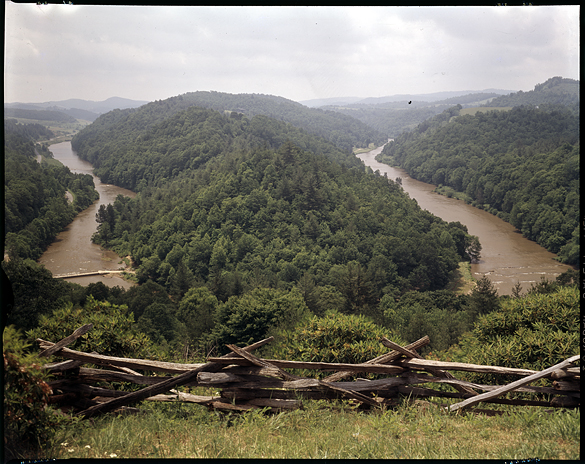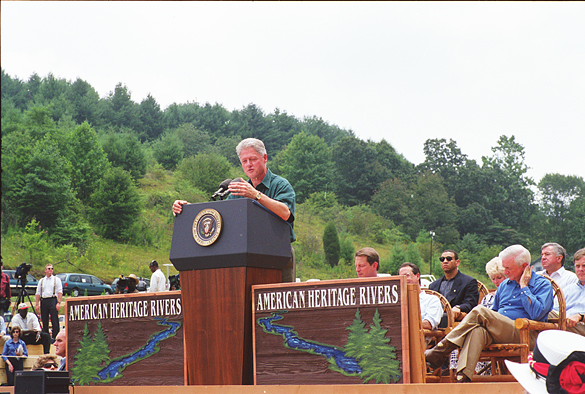
This coming Saturday, July 23rd 2011, will be New River Celebration Day at the New River State Park located near Laurel Springs in Ashe and Allegheny counties of North Carolina. What’s to celebrate? The river itself—the second oldest in the world—whose very nature survived a decade-long threat in the 1960s and 1970s.
The north and south forks of the New River wend their northerly way through northwestern North Carolina, meeting at their confluence to form the river’s main stem near the Virginia border. The region had been traditionally rural farmlands, but on March 11, 1963 the Appalachian Power Company (APCO), a subsidiary the American Electric Power Company (the largest electric utility in the country) received permission from the Federal Power Commission to conduct a two-year feasibility study for the potential generation of hydroelectric power on the upper New River.
As a result, on February 27, 1965 APCO filed an application for its “Blue Ridge Project”—a proposal for a non-federal hydroelectric power project to construct two dams on the New River in Grayson County, Virginia with the upper dam’s reservoir extending into North Carolina. The reservoirs would have a combined surface area of more than 19,000 acres. In 1966, however, the Department of interior proposed a larger project that would help flush pollution from the Kanawha River farther downstream, which eventually became known as the Modified Blue Ridge Project. That plan called for more than 38,000 to 42,000 surface acres, requiring the displacement of least 2,700 inhabitants in nearly 900 dwellings, plus numerous industries, churches, cemeteries, and other structures. And the power generated by the project was not for local resources but for distant customers.
In protest, citizens mounted a preservation effort that was soon joined by both the state and federal governments. The New River was not alone, however, in its plight. The nation was undergoing a revitalized environmentalism movement in the 1960s, and the condition of America’s rivers emerged as a major concern. On October 2, 1968, the United States Congress enacted the Wild and Scenic Rivers Act, which specified three river segments within the country that qualified for protection, including a 26.5-mile stretch of the New River from its confluence with Dog Creek to the Virginia border. With passage of this law, protected rivers could become part of a National Wild and Scenic Rivers System and the law offered two paths to achieve that protection.
The battle for the New River that followed was long and complex. What is interesting from the Hugh Morton perspective is that the early stages of the preservation effort were in play when Morton briefly campaigned as a candidate for governor the Democratic Party in late 1971 and early 1972. The headwaters of South Fork of the New River start from a spring at Blowing Rock in Watauga County, which as the crow flies is not far from Grandfather Mountain in Avery County. Research into Morton’s campaign might reveal if he ever spoke publicly about the subject.
The following few years saw the first statewide effort to fight for the New River, including the Committee for the New River in January 1975. The National Committee for the New River organized in 1974. (A NCNR map of the project illustrates the area that would have been effected by the project.) On May 26th, 1975 the North Carolina General Assembly designated that same 26.5 mile stretch of the New River included in the federal Wild and Scenic Rivers Act as a State Scenic River. Morton’s photograph above dates from May 1975, one of several he took that month. In 1976 the New River obtained its status as a National Scenic River, and the New River State Park opened in 1977.
You can read more about the efforts to protect the New River in
- Jay Wild’s History of the Management Plan for the South Fork of the New River in N.C., from the proceedings of the New River Symposium for 1984;
- Robert Seth Woodard Jr.’s Master thesis, The Appalachian Power Company Along the New River: The Defeat of the Blue Ridge Project in Historical Perspective, from Virginia Tech in 2006; and
- Thomas J. Schoenbaum’s The New River Controversy (New Edition, 2009)
Morton and camera returned to the New River once again on July 30th, 1998 to photograph the ceremony designating the New River as an American Heritage River, an event attended by both President Bill Clinton and Vice President Al Gore. Clinton created the American Heritage Rivers Initiative by executive order on September 11, 1997.


What an uplifting article. It is great to see that there are instances where the environmental concerns win out over the short term gains of a power company. I never cease to be amazed at what harm people are willing to inflict on the planet for profits. If we just use a little creativity and look long term, our energy needs can be met in ways that don’t do lasting harm to our environment. So kudos to all the people that made this happen. It’s a great example of what can be done by a determined group of people. Cheers! Mark
All of us were incensed at the plans made that would have destroyed the New. If you knew Hugh you would know that he would do all that he coiuld to prevent having them carried out. They got very far along, most seriously the use of eminent domain in acquiring the land along the beautiful river which had belonged to some of the families for two hundred years. The sad thing was that after the program was halted the land owners couldn’t get the land back.
We heard one funny story from Nelson Benton who was covering the Energy story for CBS from Washington at the time. He said he went by the office of whoever the Big Shot was who had the final responsibility to carry out the plan to talk about it and was shown a large pile of mail the proposal had generated. Nelson said he looked at it and spotted a post card with Hugh’s signature on it on the top. He picked it up and handed it to the Big Shot and said, “I don’t know what this man has asked you to do, but you should do it.” What a wild coincidence!